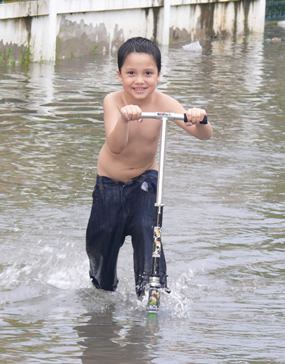 |
|
 |
|
Snap Shots: by Harry Flashman
|
|
|
Been a little wet recently!

I must buy a new car - or even a ‘newer’ car that does not leak. At this time of
year in the wet season, the inside of my car would make a wonderful breeding
ground for a family of turtles and the odd goldfish.
So what has that got to do with photography? Quite a lot actually. Look at the
photograph with the column this week. It had rained very heavily, and the
drainage system in this village could not cope (as usual) and flooding was
prevalent. I was driving along and children appeared, playing in the waters with
their scooters. The photo opportunity was just wonderful and I had the camera in
the car. What is more, I had space on the memory chip, the batteries were fully
charged, and I was ready to shoot. And I could do this within the (watery)
confines of my car.
I took about a dozen shots, and have published one which I particularly like. It
shows children being children, and enjoying everything that being a child can
bring to them. Something that we adults forget to do.
However, to get this shot it was necessary for me to “be prepared”. Being
prepared is having your camera ‘waterproof’. To do this 100 percent you can buy
a Nikonos underwater camera at the cost of many thousands of baht. These are
wonderful underwater cameras but for this instance - totally impractical, unless
you want to stand at the side of the road in a full wet-suit!
The second way is to purchase a fancy plastic underwater housing for your own
camera. Now these can range in price, depending on complexity. Built like a
perspex box to house your camera, you can operate all the adjustments from the
outside. These are not cheap either, and the cheapest in the range is literally
a plastic bag with a waterproof opening and a clear plastic section for the
lens. You open it up and literally drop your camera inside it and seal the bag.
These can be purchased from major photographic outlets and I did spot one in a
photo-shop for B. 750.
A third way is a waterproof disposable camera (yes, they do make them). Good for
about three meters, so perfectly suitable for rainstorms. If you can’t get one
of those, then even the ordinary cheap disposables are a better option than
getting your good camera gear doused. I must admit to having dropped one of
these overboard one day and the boatman jumped and retrieved it and the final
photos were fine - but that was in the days of film, and not fancy electronics.
So you are left with an even simpler way of making your camera waterproof. And
cheaper. It consists of a couple of plastic bags, such as you get with every
item in 7-Eleven, and a handful of rubber bands. Place the camera body in one
bag, with a hole cut for the lens, then place the lens in the second bag with a
hole cut at each end, and insert the lens into the camera body. Keep everything
together with rubber bands and your 7-11 waterproof housing is ready!
Now, when photographing children, use the Auto setting on your camera, and that
is one of the few times I will recommend it! No, to get a good kid pic means
that you have to be totally set up and ready for that nano-second of
opportunity.
Some photographers swear by Auto-focus (AF) for this type of shot of children,
but personally I find that the noise is distracting for them. The “whiz-whizz”
of the AF attracts for the aforesaid three point four milliseconds attention
span, and then they are off again. However, the newer AF cameras (lenses) are
much quieter and are probably the best in this situation.
When it is raining, it really does mean another photographic opportunity to get
different shots. Since we get bright sun for nine months a year, make the most
of the rain!
It is a simple case of being prepared and then just jumping in to get the shots,
with kids don’t stage manage, and lots of luck!
|
|
 |
|
|
 |
|
 |
|
E-mail:
[email protected]
Pattaya Mail Publishing Co.Ltd.
62/284-286 Thepprasit Road, (Between Soi 6 & 8) Moo 12, Pattaya City T. Nongprue, A. Banglamung,
Chonburi 20150 Thailand
Tel.66-38 411 240-1, 413 240-1, Fax:66-38 427 596
Copyright ? 2004 Pattaya Mail. All rights reserved.
This material may not be published, broadcast, rewritten, or
redistributed.
|

